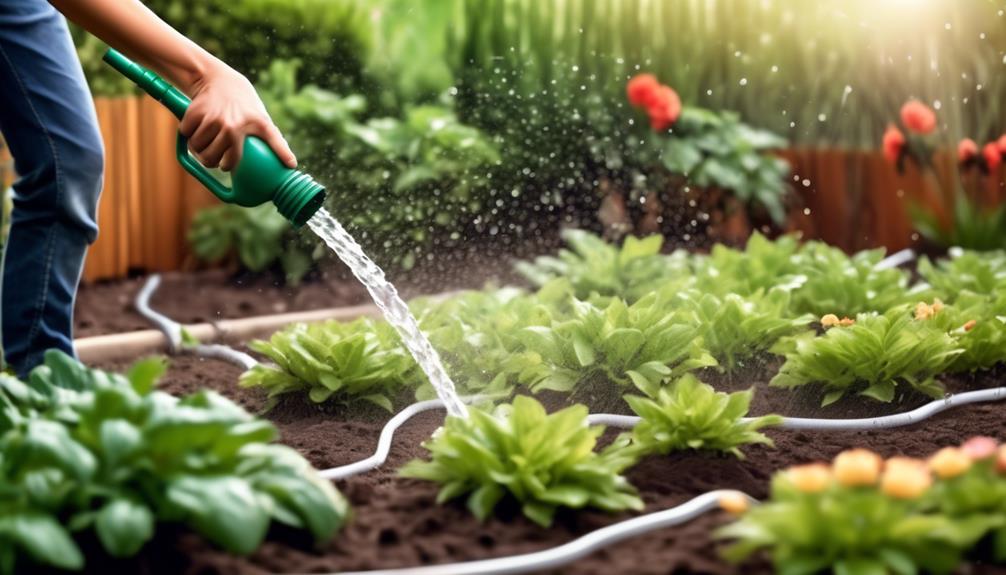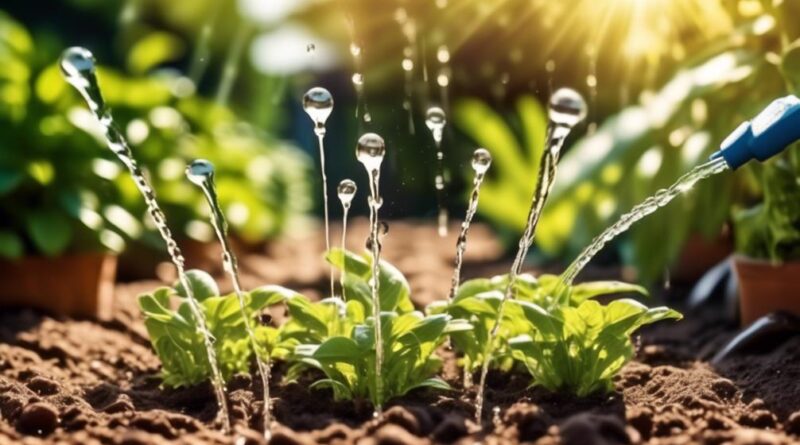Efficient Techniques for Sustainable Garden Watering
Did you know that the average American household uses around 320 gallons of water per day, with a significant portion being used for garden and lawn watering?
With the increasing concern over water conservation and sustainable living, it's crucial to explore efficient techniques for garden watering that not only conserve water but also promote healthy plant growth.
By implementing these techniques, you can not only save water but also save time and effort in maintaining your garden.
So, let's explore some smart and effective ways to ensure your garden stays lush and vibrant while being mindful of water usage.
Drip Irrigation Systems
Consider installing a drip irrigation system to efficiently water your garden while conserving water and reducing weed growth. This water-saving technology delivers water directly to the base of plants, minimizing evaporation and runoff. Drip irrigation systems provide precise and consistent moisture to your garden, promoting irrigation efficiency and healthy plant growth. These systems use a network of tubing and emitters to deliver water slowly and directly to the root zone, ensuring that water is used where it's most needed.
With a drip irrigation system, you can customize watering schedules to match specific plant requirements, reducing water waste and promoting sustainable gardening practices. By providing water directly to the root zone, these systems also help in reducing weed growth, as surface areas between plants remain dry, making it less conducive for weed seed germination. This efficient method of watering not only saves water but also reduces the time and effort required for manual watering or using less efficient irrigation methods.
Moreover, drip irrigation systems can be easily integrated with automated timers and sensors, further enhancing their efficiency by adjusting watering schedules based on real-time weather conditions and plant needs. This technology allows you to optimize water usage and minimize wastage, contributing to a more sustainable and environmentally friendly gardening approach.
Embracing drip irrigation systems is a step towards responsible water management and promoting the health and vitality of your garden.
Mulching for Water Retention
To improve water retention in your garden, mulching is an effective and sustainable technique that helps conserve moisture and promote healthy plant growth. Mulch application plays a crucial role in water conservation by reducing evaporation from the soil surface and minimizing the need for frequent watering.
When applying mulch, ensure it's spread evenly around your plants with a thickness of about 2-4 inches. This helps to create a protective barrier that locks in moisture, moderates soil temperature, and prevents weed growth, ultimately contributing to water conservation efforts in your garden.
By using mulch for water retention, you can significantly reduce the amount of water lost to evaporation, especially during hot and dry weather conditions. Organic mulches such as wood chips, straw, or compost not only help retain moisture but also contribute to the improvement of soil structure and fertility.
Additionally, inorganic mulches like gravel or pebbles can effectively conserve water by reducing evaporation and suppressing weed growth, albeit without the added benefit of soil enrichment.
Rainwater Harvesting Methods
When conserving water in your garden, implementing effective rainwater harvesting methods can significantly reduce your reliance on traditional water sources. Here are some efficient techniques for sustainable rainwater harvesting:
- Rain Barrels: Place rain barrels under downspouts to collect rainwater from your roof. This water can then be used to water your garden, reducing the need for tap water.
- Rain Gardens: Design a rain garden to capture and absorb rainwater from your property. By using native plants and creating depressions in the soil, you can create a natural filtration system that helps replenish groundwater.
- Green Roofs: Install a green roof, which consists of a waterproof membrane, growing medium, and vegetation, to capture and store rainwater. This not only reduces stormwater runoff but also provides insulation for your home.
- Greywater Recycling: Consider using greywater from sinks, showers, and laundry for watering your garden. With proper filtration, greywater can be a valuable resource for irrigation.
- Permeable Paving: Use permeable materials for driveways, pathways, and patios to allow rainwater to seep into the ground instead of running off. This helps recharge the groundwater and reduces erosion.
Selecting Drought-Tolerant Plants
Looking for low-maintenance plants that can thrive in dry conditions? When it comes to water saving landscaping, selecting drought-tolerant plants is key. These plants are well-suited to arid climates and require minimal watering once established, making them an excellent choice for sustainable garden watering.
In plant selection, prioritize species that have naturally adapted to survive with little water. Succulents, such as agave and sedum, store water in their leaves, enabling them to withstand drought conditions. Ornamental grasses like blue fescue and purple fountain grass are also great choices, as they've deep root systems that help them access water deep in the soil. Additionally, native plants are well-suited to the local climate and soil conditions, often requiring less water than non-native species.
When creating a water saving landscape, consider the overall design and layout of your garden. Grouping plants with similar water needs together can help you efficiently manage irrigation. Incorporating mulch around plants can also help retain soil moisture, reducing the need for frequent watering.
Soil Moisture Monitoring Techniques
Consider using a soil moisture meter to accurately gauge the water content in your garden's soil. This simple tool can help you determine when and how much to water, ensuring your plants receive the right amount of moisture for healthy growth.
Soil Moisture Monitoring Techniques
- Watering Frequency: Soil moisture sensors provide real-time data on the water levels in the soil, allowing you to adjust your watering schedule based on the actual needs of your plants.
- Efficient Water Usage: By using soil moisture sensors, you can prevent overwatering, which not only conserves water but also prevents waterlogged soil that can harm plant roots.
- Optimal Plant Health: Monitoring soil moisture levels with sensors ensures that your plants receive adequate hydration, leading to healthier and more vibrant growth.
- Customized Watering: Soil moisture meters enable you to tailor watering to the specific requirements of different areas in your garden, ensuring all plants receive the appropriate amount of water.
- Resource Conservation: By accurately measuring soil moisture, you can minimize water waste and contribute to sustainable gardening practices.
Smart Watering Schedule
To create a smart watering schedule, assess the specific water requirements of each plant in your garden based on factors such as soil type, sunlight exposure, and individual growth stages. Soil moisture plays a critical role in determining the watering needs of your plants. Different plants have different moisture requirements, so it's important to understand the moisture levels preferred by each type of plant in your garden. By knowing the soil moisture preferences of your plants, you can tailor your watering schedule to meet those specific needs, thereby promoting healthier growth and conserving water.
Water conservation is a crucial aspect of creating a smart watering schedule. By understanding the moisture retention capabilities of your soil, you can avoid overwatering, which not only wastes water but can also lead to root rot and other plant health issues. Furthermore, by scheduling your watering times during the cooler parts of the day, such as early morning or late evening, you can reduce water loss due to evaporation and ensure that more water reaches the plants' roots.
Efficient Use of Watering Tools

Efficiently using watering tools can complement your smart watering schedule by ensuring that the right amount of water reaches your plants' roots without wastage or overwatering. By employing water saving nozzles and precision sprinklers, you can maximize the effectiveness of your watering efforts.
Here are some tips for efficient use of watering tools:
- Water saving nozzles: Consider using water saving nozzles for your hoses and watering cans. These nozzles are designed to control the flow of water, reducing wastage and ensuring that the water is directed precisely where it's needed.
- Precision sprinklers: Invest in precision sprinklers that can be adjusted to deliver water directly to the root zones of your plants. This targeted approach helps to minimize water loss through evaporation and ensures that the plants receive the optimal amount of water.
- Drip irrigation systems: Install a drip irrigation system for your garden beds and containers. These systems deliver water slowly and directly to the soil, reducing runoff and evaporation while promoting deep root growth.
- Soaker hoses: Utilize soaker hoses, which release water along their length directly into the soil. This method is effective at preventing water waste and ensures that the roots receive a thorough soaking.
- Watering wands: Use a watering wand with a shut-off valve to control the flow of water at the source. This allows for precise watering and minimizes water usage.
Proper Watering Techniques
To properly water your garden, it's essential to understand the specific needs of your plants and the most effective techniques for delivering water to them. Deep root watering is a highly efficient method that promotes healthy plant growth. By directing water straight to the roots, plants are encouraged to develop deep, strong root systems. This can be achieved by using a soaker hose or drip irrigation system, allowing water to slowly penetrate the soil and reach the roots where it's needed most.
Additionally, preventing surface runoff is crucial for maximizing the effectiveness of watering. When water runs off the soil surface before it can penetrate the root zone, it leads to wastage and can contribute to erosion. To prevent surface runoff, consider watering in shorter intervals, allowing the water to be absorbed gradually. Adding a layer of organic mulch around your plants can also help to retain moisture, reduce surface evaporation, and minimize runoff.
Incorporating these techniques into your watering routine not only ensures that your plants receive the water they need, but also promotes water conservation. By delivering water directly to the root zone and preventing runoff, you can make the most of every drop, reduce water waste, and contribute to the overall sustainability of your garden.
Frequently Asked Questions
What Are the Best Types of Plants to Grow in a Sustainable Garden for Water Conservation?
For water conservation, choose plants like succulents, lavender, and ornamental grasses. They thrive in well-draining soil. Companion planting with herbs like basil and mint can also help conserve water by reducing evaporation and promoting soil moisture retention.
How Can I Prevent Water Wastage When Using a Drip Irrigation System?
To prevent water wastage with a drip irrigation system, adjust the flow rate to match your plants' water needs. Use soil moisture sensors for accurate irrigation. Mulch your garden to retain moisture and consider installing a rain sensor to prevent unnecessary watering.
Are There Any Specific Regulations or Guidelines for Rainwater Harvesting in My Area?
In your area, specific regulations may exist for rainwater collection. Check local guidelines to ensure compliance. Sustainable gardening practices, including rainwater harvesting, can benefit soil health and reduce water consumption.
What Are the Potential Drawbacks of Using Drought-Tolerant Plants in My Garden?
Using drought-tolerant plants in your garden can lead to drawbacks like maintenance challenges and potential water consumption. While they can save on water bills, you may also face cost implications and aesthetic concerns.
Is There a Recommended Maximum Frequency for Watering Plants in a Sustainable Garden?
You should consider the recommended frequency for watering plants in sustainable gardening. It's crucial to follow sustainable practices to conserve water and promote plant health. Monitoring soil moisture and adjusting watering schedules accordingly can help.
Conclusion
In conclusion, by implementing efficient techniques such as drip irrigation, mulching, rainwater harvesting, and selecting drought-tolerant plants, you can sustainably water your garden.
Monitoring soil moisture, following a smart watering schedule, and using watering tools efficiently are also key to conserving water.
By practicing proper watering techniques, you can ensure that your garden stays healthy while minimizing water usage.
It's important to be mindful of water conservation in order to maintain a sustainable garden.
